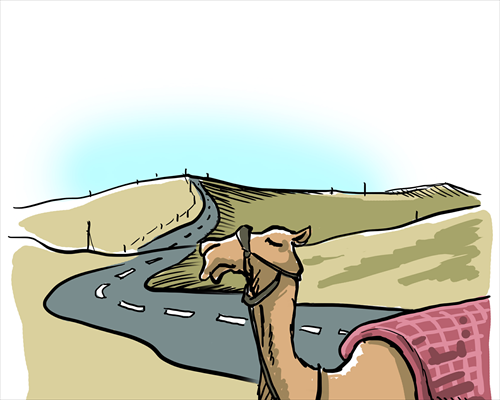'New Silk Road' can be tailored for each side

Illustration: Liu Rui/GT
Editor's Note:
At the "Asian Security and Development Cooperation: Challenges and Opportunities" conference, a prelude to the Conference on Interaction and Confidence-building Measures in Asia (CICA) summit to be held in Shanghai in May, scholars and experts discussed building the "New Silk Road" economic belt, a concept raised by Chinese President Xi Jinping in September, by joint efforts.
Ye Hailin, secretary general of the Center for South Asian Studies at the Chinese Academy of Social Sciences
In the past, China tended to work on economics and trade partnerships on an equal basis with all members within a certain sub-region, which was likely to encounter unsolvable problems such as territory issues.
Therefore, the "New Silk Road," which is a more selective methodology that prioritizes cooperation with certain countries within a smaller area, is a sensible alternative.
Yet, the question of who China prioritizes cooperation with begs the Chinese government to first give a clarification of its partnering strategy. Only by doing so can neighboring countries respond more positively.
From the perspective of China, an ideal blueprint of the "New Silk Road" would include the establishment of energy conduits and a transport infrastructure with a starting point in China. But it is crucial to combine it with various plans of different participating countries.
There must be conduits, railways, highways and the like linked to the infrastructure to make the "New Silk Road" literally an economic belt rather than a number of economic points.
Thus we should scrutinize the industrial structures of different countries and listen to their needs.
For example, it might be a good idea to build high-speed railway in Thailand, but in Laos where there are considerably fewer business travelers, it might not be appropriate.
The "New Silk Road" economic belt should not only be meaningful to the departure country and the destination country, but every country in between. Every country along the route should benefit, no matter how short the part that traverses it.
Wu Bingbing, associate professor at the Department of Arabic Language and Culture, Peking University
The building of the "New Silk Road" economic belt is not due to exterior pressure, but interior needs.
To China, challenges in security issues, social development and the like put developing the West on the agenda.
To other Asian countries, the inner-connection will lead to more development opportunities and promote the liberation and unification of trade.
The interior need is even more so as the international energy and natural resource landscape witnesses changes. Both the natural gas revolution in North America and the sanctions on Russian oil and gas due to the Ukraine crisis might make Asian countries more closely connected in terms of energy and natural sources.
Both Kuwait and Jordan have expressed great interest in the economic belt.
Afghanistan urgently needs investment in infrastructure, which necessarily requires a connection between Afghanistan and nearby countries.
A lot of countries have been asking if they can be involved in the project, and I think that any country, even the US and the EU countries, can participate.
Meanwhile, the economic belt can be not just about the economy, it is simultaneously an open economic system, a cooperative security system, and also an inclusive cultural system.
The spirit of the Silk Road emphasizes the diversity and cohesion of culture, and the diversity and cohesion of Islamic culture in the Arab world and beyond is especially important.
Christophe Bahuet, country director of UNDP in China
At the time of the ancient Silk Road, the world was no less diverse than today, perhaps in fact even more diverse, and there were less connecting points.
Today we also have a new and stronger political push, which adds a new and very important dimension.
When we come to the "New Silk Road," it is very appealing concept with huge potential. The UNDP among others have started some projects to revive the Silk Road, in trade and economic cooperation as well as in tourism exchanges.
It is important to be very clear that realizing the potential of this concept begs the question of how you define and approach the "New Silk Road." It cannot be about the economy alone.
The CICA should also include diplomacy centered around agriculture, food security, and natural resources. This is an important part of the creation of the "New Silk Road."
It can be defined as a framework under which both countries and organizations can make great contributions.